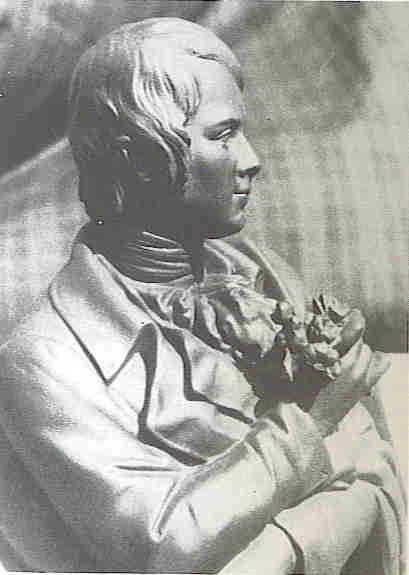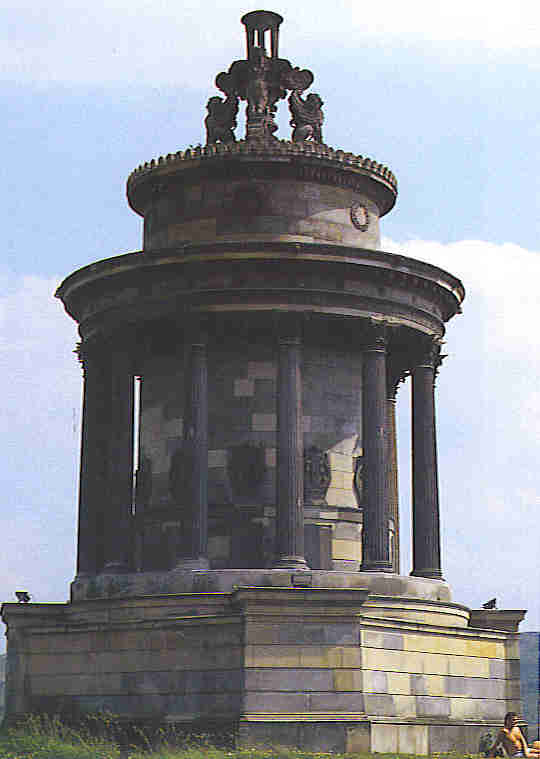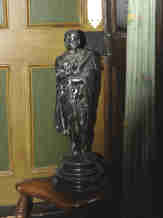|
Edinburgh Monument and Statue
I would welcome photographs of this monument ans also the Statue within it.
Whereas Ayr got a monument without a statue, Edinburgh got a statue, and then decided to have a monument, almost as an afterthought because the money raised for the statue exceeded actual requirements.
The idea for a monument in Edinburgh to Robert Burns was first proposed in Bombay in 1812 and later developed at the Freemason's Tavern in London. The campaign started in earnest in 1819, and by 1824 a marble statue ( now in the Scottish National Portrait Gallery ) was commissioned from sculptor John Flaxman.
The initial idea was to have a statue of Burns in some conspicuous site in the Scottish capital.
Inevitably the initial enthusiasm soon waned, and subscriptions came in very slowly, forcing the committee to revise their ambitions very drastically. Five years after the fund was launched, the commission to sculpt the statue was given to John Flaxman in July 1824.
Flaxman (1755-1826) was the foremost British sculptor of his day and he worked on a life-size marble statue of the poet. The head was clearly modelled on Nasmyth, but the rest was the London sculptor's own concept of what Burns would have looked like.
He is shown clad in a plaid and knee breeches. A broad bonnet with a thistle in it lies at his feet, beside a ploughshare. His arms are folded and he holds a bunch of daisies in one hand and a scroll of paper in the other. The square pedestal has a panel in bas-relief showing a seated figure of the bard being crowned by his muse.

Edward Pinnington, the celebrated art critic, discussed the Flaxman statue in the Art Journal (August 1897) as 'a fair example of the sculptor's mastery of technique. The chiselling is superb. In certain passages a desire may arise for finer discrimination, a more sensitive appreciation of the subtleties of texture, but as a whole the statue is the product of a highly accomplished sculptor who found a keen delight in the practice of his art.'
In point of fact, Flaxman died before he could finish the statue, so this task fell to his pupil and brother-in-law, Joseph Denman. Flaxman, following in the selfless traditions of Nasmyth and Beugo, Hunt and Hamilton, generously agreed to carry out the work regardless of remuneration.
In the end, however, the fund raised twice as much as the £1,400 required and the unexpended portion was then put to erecting a monument in which to house the statue. Thomas Hamilton, architect, who had already designed the Alloway Burns Monument gave his plans free of charge. The foundation stone was laid in 1831 and the temple was completed within the year. The final stone was laid on the topmost tripod on 8th September 1831. The monument was transferred to the City of Edinburgh by the committee in September 1839. A few years later Henry Scott Riddell, the all but forgotten author of Scotland Yet, donated the proceeds from his song to defray the cost of an ornamental railing round the monument.
Hamilton based the design on the Choragic Monument of Lysicrates which commemorated dramatic performances in ancient Athens, whose prize was a bronze tripod which surmounts the monument. The poetry garden around the monument is planted with flowers mentioned by Burns in his poetry, which convey his love of nature and life.
Winged lions support the tripod and sit on acanthus leaf scrolls.
Lyres around the centre of the monument relate to poetry and song.
The fluted Corinthean columns have beautiful carved acanthus leaf capitals with a central carved flower.
Laurel wreaths around the monument bestow honour on Burns.
The roof is also covered with laurel wreath carved stone.
A honeysuckle motif can be seen all around the monument
The edifice was soon found to be too cramped to show the statue to advantage, and fifteen years later it was removed and re-erected in Edinburgh University library. Dr John Lee, Principal of the University, objected to this on the specious grounds that Burns did not have a college education. Following a protracted correspondence between the University and the Town Council of Edinburgh, the statue was removed in 1861 to the National Gallery of Scotland in Princes Street. There it remained until the Scottish National Portrait Gallery was opened in 1889. It has stood in the entrance hall of the Gallery ever since, where it can be seen and admired in an ideal setting.

From 1846 onwards the monument itself, like its Alloway counterpart, was used as a museum for Burns relics, but in 1901 the relics themselves had to moved to the Corporation Museum on account of damage from damp. The Edinburgh monument is, in truth, a cenotaph - literally an empty tomb. Extensive renovation was carried out in 1961 and the monument re-opened to the public, but there has never been any suggestion that the Flaxman statue should be returned to its original location.
In 2009, after 10 months under scaffolding, during which time £300,000 was spent in further restoration, the beautiful Burns monument was rededicated.
Flaxman's preliminary model of the statue was subsequently acquired by George Thomson who presented it to Colonel William Nicol Burns in 1847. John Irvine made a drawing of it in 1844 which was later engraved by H. Cook. One of these prints may be seen in the Birthplace Museum.
Bronze reductions are also known, one being displayed in the Globe Inn, Dumfries.

A half-sized replica in painted bronze occupies a niche above the Robert Burns Lounge in Perth.
|
| |
